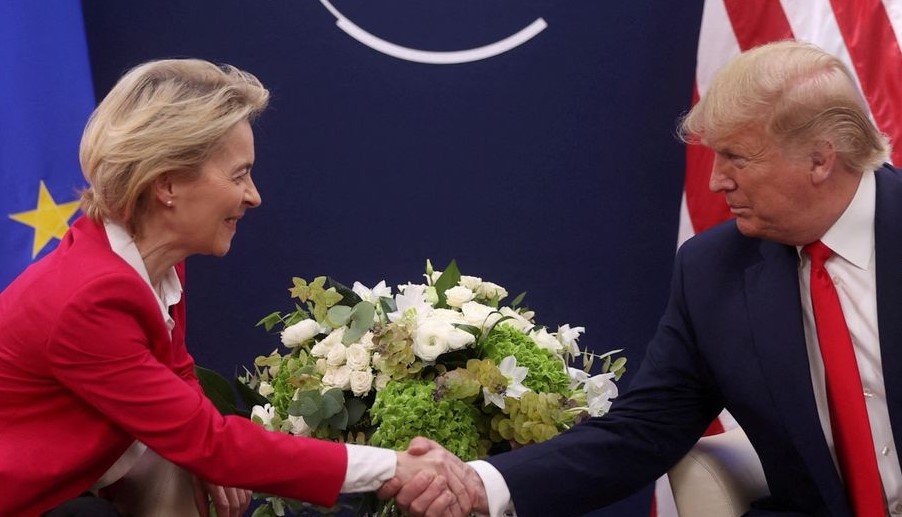Historic 15% tariff deal reshapes transatlantic trade, locks in energy and investment windfalls
It could’ve turned ugly. With only days to spare before a 30% tariff wall was set to slam into European exports, Washington and Brussels pulled off a massive, face-saving compromise — one with real teeth. The new deal? A flat 15% tariff, $750 billion in EU energy purchases, and $600 billion in investment commitments flowing into the U.S.
The agreement, hammered out in-person at President Trump’s Turnberry resort in Scotland, isn’t just a symbolic handshake. It’s a $1.35 trillion handshake — one that both sides hope signals the end of years of icy trade tension.
From Turnberry, With Steel Nerves
Trump loves a spectacle, and this deal got one. Against the windswept greens of his luxury golf course in southwest Scotland, he stood next to European Commission President Ursula von der Leyen. Cameras rolled. Smiles were tight.
“I think it’s going to be great for both parties,” Trump said, never straying too far from his favorite word: “fairness.”
The timing was key. With the August 1 deadline looming and markets jittery over escalating tariffs, the in-person meeting signaled urgency.
Von der Leyen, measured but relieved, framed it as a win-win: “It will bring stability. It will bring predictability. That’s very important for our businesses on both sides of the Atlantic.”
One sentence. Quiet but clear.

What’s Actually In the Deal?
On paper, the new deal offers three key outcomes — each carrying real-world financial punch:
-
A flat 15% tariff on all EU exports to the U.S., replacing the previously proposed 30% rate.
-
A $750 billion commitment by the EU to purchase American energy — mostly natural gas and oil.
-
A $600 billion pledge for EU firms to invest in the U.S. economy, particularly in manufacturing and green tech.
That 15% number mirrors the terms of a recent U.S.-Japan agreement, suggesting a new baseline for American trade talks.
Winners and Losers in the New Tariff Map
The deal spares European automakers from a punishing 25% levy. That alone sent shares of BMW, Volkswagen, and Stellantis up sharply in after-hours European trading.
On the U.S. side, energy companies cheered the $750 billion purchase agreement — with LNG exporters in Texas and Louisiana bracing for a surge in demand.
Farmers, however, remain in limbo. Agricultural access wasn’t a focus this round.
Let’s break it down:
| Sector | Outcome from Deal | Who Benefits |
|---|---|---|
| Auto Industry | Tariffs capped at 15% (down from 25%) | European carmakers |
| Energy | $750B EU commitment to buy US supply | U.S. LNG & oil exporters |
| Investment Flows | $600B into U.S. economy | U.S. infrastructure & industry |
| Agriculture | No major breakthroughs | Still unresolved |
The table says it all.
A Pattern Emerges in Trump’s Trade Playbook
This isn’t a one-off. The EU pact now joins a series of last-minute trade renegotiations under Trump’s second term, where deals are struck only after brinkmanship and near-crisis. Earlier this week, the U.S. secured a similar 15% tariff framework with Japan. India is next.
Trump’s approach? Start with a threat. Then talk. Then deliver just in time.
Two sentences. Very Trump.
Yet there’s a logic to it. These hardball tactics have pushed allies to the table. Even von der Leyen acknowledged the pressure worked: “Yes, it was tense. But we did reach consensus.”
Actually, consensus may be putting it gently.
Industry Reactions: Relief, But Not Quite Celebration
U.S. steel and aluminum groups say they’re glad the 30% threat is off the table, but still feel undercut by the 15% flat rate — which they believe rewards low-cost producers in Eastern Europe.
Tech firms, meanwhile, are eyeing the $600 billion investment pledge with interest. A chunk of that is expected to land in advanced semiconductor plants, AI labs, and green energy hubs in Texas, Arizona, and Ohio.
“This is big,” said a senior executive at Intel, speaking anonymously. “We’ve had European VCs circling us for months. Now they’ve got government wind behind them.”
One small paragraph. Just enough.
The Politics: A Show of Strength Before 2026
Make no mistake — this deal lands at a politically charged moment.
Trump, with eyes on the 2026 midterms and renewed whispers of a potential 2028 run, is racking up “America First” wins abroad. Meanwhile, von der Leyen, facing blowback from French and Italian trade unions, must sell this agreement as a defensive maneuver, not a concession.
Behind closed doors, the sticking point was always tariffs on German and French carmakers. But it was energy that broke the stalemate. America’s cheap shale gas was simply too attractive for Europe’s post-Ukraine energy reset.
Basically, they needed each other.
Commerce Dept. Throws Cold Water on Extensions
While both sides appear happy, the U.S. Commerce Department was quick to clarify — this isn’t a negotiation phase. It’s a final deal.
“There are no more extensions,” Secretary Wilbur Ross said in a brief statement. “These are the terms.”
Short. Sharp. No ambiguity.
Trade watchers say the next flashpoint may be enforcement. What happens if investment targets aren’t met by 2028? Will tariffs spike again?
The answer, for now, is buried in dense fine print. But Trump — and the markets — seem satisfied, at least for the moment.
